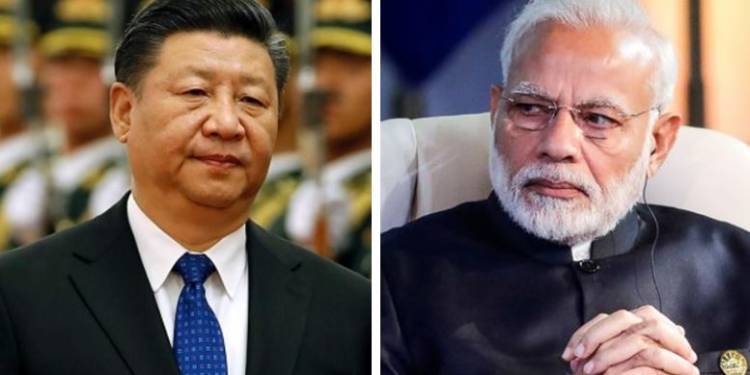The People’s Liberation Army (PLA) of China has been made to eat humble pie in Ladakh after almost a month of soaring tensions and standoff between the Indian Army and the PLA.
China had mobilised its troops, heavy vehicles, and weaponry- combat infantry vehicles and artillery near the Line of Actual Control (LAC) in Eastern Ladakh. India matched up to Chinese aggression and now China has decided to retreat. This is the second time since the Doklam standoff in 2017 that Beijing had to eat crow in a standoff situation.
The Chinese build-up was concentrated at four points- two points in the Galwan Valley region [Patrolling Points (PP) 14 and 15], Hot Springs area, and the Pangong Tso Lake where a scuffle had ensued last month.
Except for the Pangong Tso lake, disengagement has been reported from all points of confrontation. The Chinese troops have pulled back by 2-2.5 kilometres from the Galwan Valley area (PP- 14 and 15) and the Hot Springs area. Interestingly, the PLA had caved in ahead of the Major General-level talks between the two armies on Wednesday.
In fact, the Chinese Foreign Ministry has also confirmed this development, and Ministry spokesperson Hua Chunying said that both the countries are taking steps to defuse tensions along the borders, while replying to a question about disengagement and pulling back troops to their pre-standoff positions, during a media briefing.
She said, “Recently, the diplomatic and military channels of China and India held effective communication on the situation along the border and reached positive consensus.”
Hua added, “The two sides are following this consensus to take actions to ease the situation along the borders.”
Meanwhile, Beijing has underscored the need to implement “consensus” among the leaders of both the countries and to make sure that “differences do not escalate into disputes.”
China was the aggressor in the present standoff and it wanted to grab Indian territory, apart from stalling Indian border roads construction. However, New Delhi stood its ground strongly asseverating its position. The fact that Beijing had to extend the olive branch and disengage is a clear victory for the Indian Army and defeat for the People’s Liberation Army.
This discredits the PLA like never before. To mobilise on the borders and disengage within days two times in three years doesn’t augur well for the PLA.
In 2017 too, the PLA was the one that had gone out of its way on its borders with Bhutan. New Delhi had stood its ground in accordance with its obligations to protect the landlocked country.
China had been already given a bloody nose in Doklam as it had to retreat after 73 days of an eyeball-to-eyeball situation. In many ways, the Eastern Ladakh standoff has turned out to be an embarrassment even bigger than Doklam for the PLA.
During the Doklam standoff, the Chinese troops did last for 73 days but in Eastern Ladakh this time, they have pulled back in around a month, as they met an assertive Indian soldier yet again.
Moreover, during the Doklam standoff, the Chinese State media and social media was very active and kept raking up the 1962 Sino-India war apart from issuing unsubtle threats.
But this time around, the Chinese State media was more careful, apart from a few over the top editorials in the Global Times, the Chinese State media remained silent. The Communist regime also deleted the conversation on social media app, Weibo, and removed the ‘China India border confrontation’ hashtag itself that had garnered 30 million hits.
The Global Times did run an unimpressive war commentary that only exposed the incompetence and vulnerability of the PLA troops, but the Chinese defence experts remained careful, in fact, terrified of the Indian Army’s firepower.
In an article published by China’s thepaper.cn, a Chinese military expert and Senior Editor of Modern Weaponry magazine, Huang Guozhi wrote, “At present, the world’s largest and experienced country with plateau and mountain troops is neither the US, Russia, nor any European powerhouse, but India.”
The PLA has pulled back from Eastern Ladakh because it fears that its little emperors will be beaten black and blue by the world’s deadliest mountain troops in case tensions escalate.
It’s true that the Indian Army is a ferocious fighter with rich experience of winning battles and wars in high-altitude areas like Siachen and the Kargil sector. Last year, India also conducted war games near the China border in Eastern Ladakh.
On the other hand, the PLA has no rich battle experience, and has few military exploits to boast about. Moreover, most of the Chinese military commanders have no battle experience. The handful of combat veterans who already do not have an encouraging war history to boast about are going to retire within the next few years.
The Chinese People’s Liberation Army consists of wimps, sissies & little emperors- a fallout of its “one-child policy”. The “spoiled” Chinese troops thus are no match for the tough Indian Army soldiers who are always high on the regimental spirit.
China is nothing but a giant origami and the People’s Liberation Army is no match for the Indian Army- New Delhi proved this to the world in Doklam in 2017 and has now proved in Eastern Ladakh. The paper tigers of China have been given a bloody nose yet again, and Beijing is trying hard to hide it all over again.
